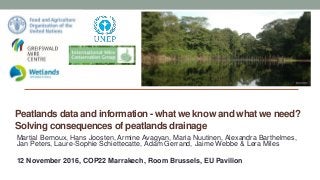
Peatlands data and information - what we know and what we need?
- 1. Peatlands data and information - what we know and what we need? Solving consequences of peatlands drainage Martial Bernoux, Hans Joosten, Armine Avagyan, Maria Nuutinen, Alexandra Barthelmes, Jan Peters, Laure-Sophie Schiettecatte, Adam Gerrand, Jaime Webbe & Lera Miles 12 November 2016, COP22 Marrakech, Room Brussels, EU Pavilion Photo: Alue Dohong
- 2. What countries need to improve peatland management? High-resolution data and information on organic soil (peat) areas and their drainage status These need to be used for: Capacity building for rewetting and wet use options (paludiculture = GHG emission reductions) Policy guidance to harmonize regulations for more sustainable land use management, tenure Finance to develop specific wet use options and to implement them.
- 3. Addressing peat data needs Source: FAO, 2014 • Harmonizing information from different sources • Exact locations of peat soils and their status to guide land management • Guidance on: how to i) map organic soils, ii) monitor peatland restoration and ii) report on GHG emissions
- 4. Addressing peat data needs Japan Iceland Canada Ukraine USA Belarus RussianFederation EU Mozambique Zambia Bangladesh Myanmar Brazil Malaysia PapuaNewGuinea Mongolia China Indonesia 0 20 40 60 80 100 3 Parties: 1.125 Mt, 70 % 7 Parties: 1.340 Mt, 80 % 13 Parties: 1470 Mt, 90 % 24 Parties: 1550 Mt, 95 % 0 200 400 600 800 1000 1200 1400 1600 Mt CO2e % Australia Guinea-Bissau Norway India Vietnam NewZealand Guyana 25 countries are responsible for 95% of global peatland emissions.
- 5. Data on subsidence and biodiversity loss Land loss: Subsidence can be up to 2.5 metres after 25 years of drainage. Biodiversity loss – case of mammals in Indonesia: Peatland conversion contributes to the biodiversity loss. • Over the last 75 years, the number of Sumatran orangutans has declined by 80%. • Currently, there are only 400 Sumatran tigers living in the wild. Dissolved organic carbon loss: When intact peatlands are drained carbon losses via water increase by 50%. Overall: loss of adaptive capacity and ecosystem services This loss can be quantified.Photo: Jauhiainen Jyrki Peat subsidence at oil palm plantation
- 7. FAO EX-ACT tool: GHG estimations from peatlands management ○ Based on the methodology from the IPCC 2006 and updated with the Wetlands Supplement 2013. ○ Activity’s impact on GHG emissions can be estimated from: • Inland organic soils: drainage, fire, rewetting and peat extraction • Coastal wetlands: extraction, drainage and rewetting • User can insert own data on GHG emissions (Tier 2) ○Refining the tool with Indonesian Peatland Restoration Agency (BRG): • estimating the emission reduction potential for restoration of 2 million ha of drained and degrading peatland under different management practices • supporting moratorium on 4 million hectares of peat swamp forest. www.fao.org/tc/exact/accueil-ex-act
- 8. FAO Collect Earth tool: monitoring land use change 1. OpenFORIS tools are used in over 20 countries, free, easy software for forest data analysis 2. Collect Earth uses Google Earth samples • Fast visual classification using high- resolution images in a few clicks • Rapid monitoring of land cover changes (e.g. clearing of peat swamp forests) • Can be used for forest cover change statistics (IPCC/UNFCCC)
- 9. Collect Earth in Indonesia ○ bullets More info: www.openforis.org 36 people completed over 8 000 points across Indonesia in 5 days
- 10. Rapid assessment on global peatlands, 2017 • Call for policy attention to peatlands • Current knowledge & data needs • Showcases • ecosystem services (e.g. water, climate mitigation, biodiversity) • policy context • drivers of drainage and fire • Gives a future outlook and recommendations • Collaborative effort of the members of the Global Peatlands Initiative Photo: Tony Hisgett, Sumatran tiger.
- 11. Key messages - 1 1. Most countries have peatlands and should take them into account in climate action. • Guiding land management, especially avoiding drainage • Reporting GHG emissions, if peatlands are drained, degraded or burned 2. Globally the peatland area is relatively small and scattered but globally significant. Photo: FAO, Burera lake in the Kagera region, Rwanda.
- 12. Key messages - 23. Solutions exist for restoring peatlands. 4. Avoiding conversion is still the most effective means to avoid emissions. 5. Develop capacities in countries to: • Map peatlands and their drainage status in high resolution • Manage and govern: harmonize policies, guide in practices • Phase out unsustainable land-use and develop drainage-free alternatives for livelihoods • Measure, share best practice and report the progress.
- 13. Thank you for your attention www.globalpeatlands.org micca@fao.org Jaime.webbe@unep.org
- 14. Extra slides
- 15. • Guidebooks to decision makers and land managers & submissions to UNFCCC • Evaluate and record peatlands management practices • EX-ACT tool to estimate GHG emissions from rewetted peatlands Proveds data & synthesizes global information • Exchange information through online discussion group • Organize expert workshops and online learning events Facilitates knowledge sharing • Sustainable inland fisheries in burned peatlands •Preparing to pilot and test various paludiculture species jointly with the Government of Indonesia and partners. Pilots options for drainage-free livelihoods www.fao.org/in-action/micca/knowledge/peatlands-and-organic-soils/ FAO’s work on peatlands in wet state
- 16. Global Peatlands Initiative and its objectives (phase 1) AT THE GLOBAL LEVEL • Provide an updated overall assessment of the status of peatlands and their importance in the global carbon cycle and to national economies. AT THE NATIONAL LEVEL • identify and begin to respond to the needs of pilot countries with substantial peat coverage through building the knowledge base and developing options to reduce degradation. • improve the sustainability of peatland management including through restoration and the development and adoption of sustainable peatland strategies and action plans.
